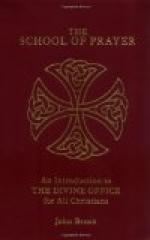But the question arises, when did Rome introduce hymns into her liturgy? The learned Jesuit, Father Arevalo, held that the Roman Office had hymns as an integral part from the time of St. Ambrose, and he called the opinion of those who held that they were of later introduction an inveterate error, errorem inveteratum (Hymnodia Hispanica XVIII., n. 95). The introduction of antiphonal chanting was introduced into Rome at the time of St. Ambrose and liturgical hymn singing, too, was introduced about the same time. This we know from the Milanese priest Paulinus, St. Augustine, Pope Celestine I., and Faustus, Bishop of Riez. But formal, official and systematic hymnody was not introduced in Rome until centuries after the death of St. Ambrose. Mabillon (Suppl. ad IV. lib de div. off. Amalarii, t. 11) and Tomasi (In annot, ad Resp. et antip. Rom. Ecc.) place the date of the introduction of hymns into the Roman liturgy, in the eleventh or twelfth centuries. But scholars now agree that hymns were formally recognised in the liturgy of Rome in the latter half of the ninth century. “To judge of what Amalare of Metz says, there was no sign of it at the beginning of the ninth century, but from the middle of the same century onwards hymns must have been introduced into the Office used by the Churches of the Frankish empire, and shortly afterwards in Rome” (Baudot, op. cit., pp. 67-68). Wilfrid Strabo agrees with Amalare. Rabanus Maurus testifies that hymns were in general usage in the second part of the ninth century. (Migne, Pat. Lat. clx. 159, cxiv. 956). This is the opinion of Gueranger, Pimont, Blume and Baumer.
Dom Gueranger explains why Rome, the mother and mistress of all the churches, did not adopt the practice of hymn chanting in her liturgy for centuries; why she did not precede or quickly follow the Eastern and many parts of the Western Church in this matter of liturgical hymns. “The Church,” he says, “did not wish to alter by religious songs the simplicity, or the meaning, of her great liturgical prayer. Nor did she wish to adopt quickly any innovation in her liturgy or discipline” (Inst. Liturg. I. 1, pp. 170-171).
No part of the Church’s liturgy has met with such persistent, abusive, and often ignorant criticism as her hymns have received.
The renaissance clerics, the Gallicans, the Jansenists, and the Protestants poured forth volumes of hostile and unmerited criticism on the matter and form of Rome’s sacred songs. Becichemus, rector of the Academy of Pavia in the sixteenth century, in his introduction to the work of Ferreri, wrote of the hymns: “sunt omnes fere mendosi, inepti, barbarie refecti, nulla pedum ratione nullo syllabarum mensu compositi.... Ut ad risum eruditos concinent, et ad contemptum ecclesiastici ritus vel literatos sacerdotes inducant.... Literatos dixi: nam ceteri qui sunt sacri patrimonii helluones, sine scientia, sine sapientia, satis habent, ut dracones




